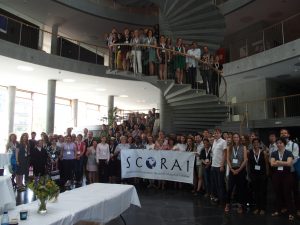Last Saturday morning was sunny and lazy and I was still in bed when I stumbled upon the New York Times article “To Build Resilience in Isolation, Master the Art of Time Travel: When the present is unpleasant, it helps to think ahead to the future and back to the past.”
The piece, by Adam Grant, is a beautifully written reflection upon ways of coping with difficult situations. Grant compares being in Covid19-induced isolation to some of Scott Kelly’s experiences being confined whilst travelling in space. In both situations, the present feels uncertain, somewhat limited and the future is unpredictable. However, according to Grant, the trickiest part of being confined, doing the same few things over and over again, is that the day can become boring, and time becomes meaningless. Grant argues that when human beings are put in such situations, we tend to explore past moments of happiness as well as anticipate happy moments in the future, through sort of a mental, and rewarding, time travel.
Most of us are currently finding ourselves either confined to our homes or strictly limited in the way we go about our everyday lives, compared to what life looked like pre-Covid19, and we have been in that situation for a while now. Most of us are thinking about last summer, recalling illusive memories of hanging out with friends and family, maybe going to a party or going to the beach. Many of us might think about how we would like for that to happen again some day soon.
This means that a lot of us are currently and collectively thinking about ‘what could be’. We are anticipating.
Although a lot of our thoughts might revolve around the familiar, we are only a few mental steps away from thinking about altogether different versions of our everyday lives. We all know that social distancing might be part of our lives for quite some time, and we know that work-life may look different, post-Covid19, for many of us. Some of us have lost our jobs and some of us are warming up to the idea of basic universal incomes. Some of us are maybe even thinking about different ways of living.
Quite easily, these thoughts can be entombed in feelings of loss, maybe even despair. But that is not how it needs to be. I have heard several friends whisper – as if they were confessing something criminal – that a limited, slower pace of life has been quite rewarding. And although these feelings may come from a very privileged place, they should not be dismissed as meaningless or unjustified. As we are usually being asked to be present and available for most of our waking hours, being treated like numbers in excel-sheets, and relentlessly being subjected to efficiency measures, a slower time can really crystallize how ‘the pursuit of unlimited opportunities’ can be an unhealthy and unhappy ‘prison’. Even if that means that you have a steady job and an income.
It is important to remember that a slower pace of life, with limits, is not the same thing as a dictated life. Giorgos Kallis demonstrates this well with his work published in his book Limits, but other than that we are frequently and forcefully told that limits are bad; Capitalism, Growth and Free Markets are good – Anything else is bad. You are basically told that if you want anything else, you are against the basic rights of freedom.
But is that really so? We are now experiencing deepening cracks in the established systems that indeed build on values of growth and speed, and although we may feel utterly heartbroken that the system we once believed in is not helping us at all, it may – in the long run – be good for us to be exposed to the cracks that no one wanted us to see. Thinking about a different future, that is slower and maybe also more limited, does not have to be bad. We do not have to be worse off. But of course, we need the tools to think about this in a way that is constructive, liberating and inclusive. We need to remember that the “before”, the loss of which we are grieving, might actually have been what was confining us, and that the future can hold other ways of being free.
But what would it actually mean for us to live in new ways? What does it look like and how does it feel?
It is important that we do not just think about this as glimpses of what we think we have lost, but as an imagined new day in new surroundings, with new goals and new meanings, new values: new everydaynesses. And – importantly – how are these new versions of our lives sustainable?
As we are undergoing significant changes already – now is really the time to make sure that these changes are headed towards sustainability!
My friend Frederikke Oldin, trained in psycholinguistics and founder of FremtidsFormidlingen1 (Communication for the Future) facilitates collective Time Travels, exactly for the reason that we need to be able to imagine a sustainable future in order to ‘go there’. As an aspiring science-fiction writer of sustainable futures, I couldn’t agree more.
I have travelled to sustainable futures, facilitated by Frederikkes competent and calming voice. Having been in lock-down, the facilitation has happened online. But her voice, and her questions, are really all that is needed to instigate some very interesting thoughts.
When I travel, I sometimes travel as myself. I am quite extroverted and keen on sustainable co-housing, so it is not difficult for me to go to a place that I know to be more sustainable than most current societies (I am also a researcher, having worked with everyday life and sustainability for years). But I also travel as others, or at least with others in mind. As a writer, I care about my characters, who are going to live in a sustainable future. Frederikke helps me realize what a particular sustainable future would feel like for my characters. One of my characters is an introverted man, and he has not ‘spoken’ to me very much about his life before – probably because he and I are not really alike (well, we might be, but that is another story).
For a long time, I was afraid that he would not feel comfortable in a future where cohousing is normal, where sharing is normal, where smaller communities are normal. I was afraid that he would hate having to share spaces with others and I was wondering what type of job he would have, and if he would be happy. I was really worried about how someone, who prefers to be alone, would feel like in a future world that is perceived to be rather ‘social’ in its ways of being structured. Taking on what I believe to be his main features, I went on a time travel facilitated by Frederikke. Impersonating him, I explored where he lived, how he moved around, where he worked and how he worked, whom he interacted with and how. Although I am far from having finalized a comprehensive picture of him and his everyday life, travelling to a sustainable future as, or with, him, really exploring the nitty gritty aspects of what a life could look like, helped me understand some crucial details of his self, as part of this future. Here is a snippet from his life, written in third person (as I still don’t know his name, he will remain nameless):
“He woke up to the dancing of sunbeams, finding their way through the high window in his bed-loft. Just outside, a mosquito was already busy. It took him a few seconds to get up. Slowly, he climbed down the small ladder, leading directly towards the small kitchenette. He could do this in his sleep, and sometimes he felt like he did so, only waking up with a cup of tea settling on the tea table in front of him. He had placed the table close to the eastfacing wall, which was one big window, as he liked to sit for a while looking out on the giant spruces surrounding his home. He would often see deer walking by. He knew that at some point, they had been a rare sight, only really showing up in what had been termed ‘remote places’. It was difficult for him to picture a place where animals were a rare sight.
The wet cloth woke him up properly, as he wiped his face and body, getting ready for work. Just beside the front-door (and also conveniently placed next to the sink), the small noteboard reminded him that he had scheduled some hours at the wood-workshop in the afternoon. He was going to see Jacob there. He would have to make it back home in time to change his clothes, and as he usually forgot time at the office these days, he would need to set the alarm on his wristwatch. The four hours at the office could go by quickly, especially lately as he was diving into some newly discovered documents describing something called Wall Street. He hadn’t gotten very far yet, but he had established that Wall Street was as much a phenomenon as it had been a physical area. Being a historian had suddenly become the talk of the town after the documents had surfaced. He didn’t mind the nice ring to it, but he tried to avoid the journalists. Realizing that he had gone off into a reverie, he put on his jacket, and went outside. A smell of sun, spruce needle and old rain surrounded him, as he walked off towards the rail station, heading towards the city.”
Where would you go? What would your home look like? How small would it be? Where would you live? Who would live near you? How would you live? Who/what would you meet? When? Why? Who/what would not be there? Are their old people nearby? Young people? Animals? Who/what has access? Who/what has rights? What kind of rights?
Would you have a job? What would your job be? How often would you work? Where would you work? How would you get there? Who would you work with? How would your work life be structured? Would you get a salary? Would there be voluntary work? What would you eat? What kind of smells are there? How does it feel? What colors are there?
Would you go on a time travel, asking yourselves these questions?
Let me know what you think of this piece 🙂
- if you speak danish, or understand nordic languages, I would encourage you to visit FremtidsFormidlingens Facebookpage: www.facebook.com/FremtidsFormidlingen-104310751192084/ [↩]


